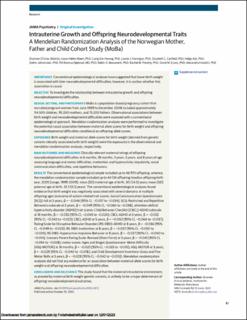| dc.description.abstract | Importance Conventional epidemiological analyses have suggested that lower birth weight is associated with later neurodevelopmental difficulties; however, it is unclear whether this association is causal.
Objective To investigate the relationship between intrauterine growth and offspring neurodevelopmental difficulties.
Design, Setting, and Participants MoBa is a population-based pregnancy cohort that recruited pregnant women from June 1999 to December 2008 included approximately 114 500 children, 95 200 mothers, and 75 200 fathers. Observational associations between birth weight and neurodevelopmental difficulties were assessed with a conventional epidemiological approach. Mendelian randomization analyses were performed to investigate the potential causal association between maternal allele scores for birth weight and offspring neurodevelopmental difficulties conditional on offspring allele scores.
Exposures Birth weight and maternal allele scores for birth weight (derived from genetic variants robustly associated with birth weight) were the exposures in the observational and mendelian randomization analyses, respectively.
Main Outcomes and Measures Clinically relevant maternal ratings of offspring neurodevelopmental difficulties at 6 months, 18 months, 3 years, 5 years, and 8 years of age assessing language and motor difficulties, inattention and hyperactivity-impulsivity, social communication difficulties, and repetitive behaviors.
Results The conventional epidemiological sample included up to 46 970 offspring, whereas the mendelian randomization sample included up to 44 134 offspring (median offspring birth year, 2005 [range, 1999-2009]; mean [SD] maternal age at birth, 30.1 [4.5] years; mean [SD] paternal age at birth, 32.5 [5.1] years). The conventional epidemiological analyses found evidence that birth weight was negatively associated with several domains at multiple offspring ages (outcome of autism-related trait scores: Social Communication Questionnaire [SCQ]–full at 3 years, β = −0.046 [95% CI, −0.057 to −0.034]; SCQ–Restricted and Repetitive Behaviors subscale at 3 years, β = −0.049 [95% CI, −0.060 to −0.038]; attention-deficit/hyperactivity disorder [ADHD] trait scores: Child Behavior Checklist [CBCL]–ADHD subscale at 18 months, β = −0.035 [95% CI, −0.045 to −0.024]; CBCL-ADHD at 3 years, β = −0.032 [95% CI, −0.043 to −0.021]; CBCL-ADHD at 5 years, β = −0.050 [95% CI, −0.064 to −0.037]; Rating Scale for Disruptive Behavior Disorders [RS-DBD]–ADHD at 8 years, β = −0.036 [95% CI, −0.049 to −0.023]; RS-DBD–Inattention at 8 years, β = −0.037 [95% CI, −0.050 to −0.024]; RS-DBD–Hyperactive-Impulsive Behavior at 8 years, β = −0.027 [95% CI, −0.040 to −0.014]; Conners Parent Rating Scale–Revised [Short Form] at 5 years, β = −0.041 [95% CI, −0.054 to −0.028]; motor scores: Ages and Stages Questionnaire–Motor Difficulty [ASQ-MOTOR] at 18 months, β = −0.025 [95% CI, −0.035 to −0.015]; ASQ-MOTOR at 3 years, β = −0.029 [95% CI, −0.040 to −0.018]; and Child Development Inventory–Gross and Fine Motor Skills at 5 years, β = −0.028 [95% CI, −0.042 to −0.015]). Mendelian randomization analyses did not find any evidence for an association between maternal allele scores for birth weight and offspring neurodevelopmental difficulties.
Conclusions and Relevance This study found that the maternal intrauterine environment, as proxied by maternal birth weight genetic variants, is unlikely to be a major determinant of offspring neurodevelopmental outcomes. | en_US |

